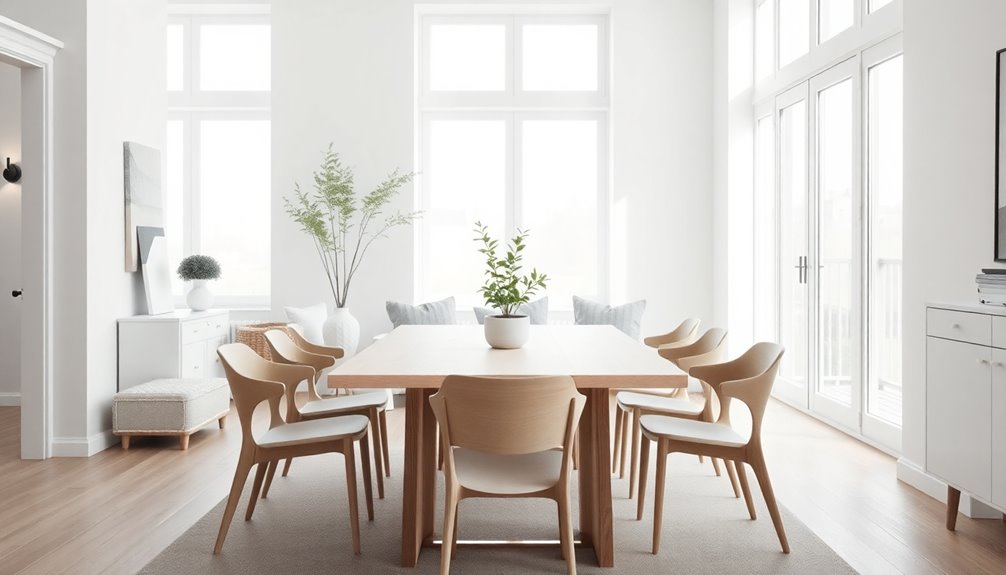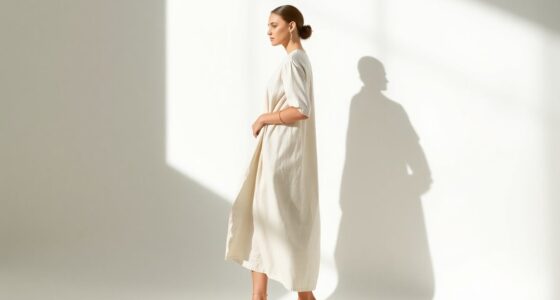Did you know that homes designed with minimalism in mind can lead to a 20% increase in perceived space? In Scandinavian design, this principle is at the forefront, blending simplicity with functionality. You might wonder how this aesthetic not only creates visually appealing environments but also fosters a deeper connection to nature. Let's explore the essential elements that make Scandinavian minimalism so effective and inviting.
Key Takeaways
- Scandinavian design prioritizes simplicity and functionality, promoting minimalism through clean lines and minimal decoration in furniture and spaces.
- The movement's roots in the Bauhaus philosophy emphasize "form follows function," ensuring designs are both practical and aesthetically pleasing.
- Multi-functional furniture is essential, maximizing space and reducing clutter while offering versatility in small living areas.
- Natural materials and a neutral color palette enhance the minimalist aesthetic, creating calming environments that connect to nature.
- Accessories and textiles are thoughtfully selected to add warmth and comfort without overwhelming the minimalist design principles, promoting a cozy atmosphere.
The Core Principles of Scandinavian Design
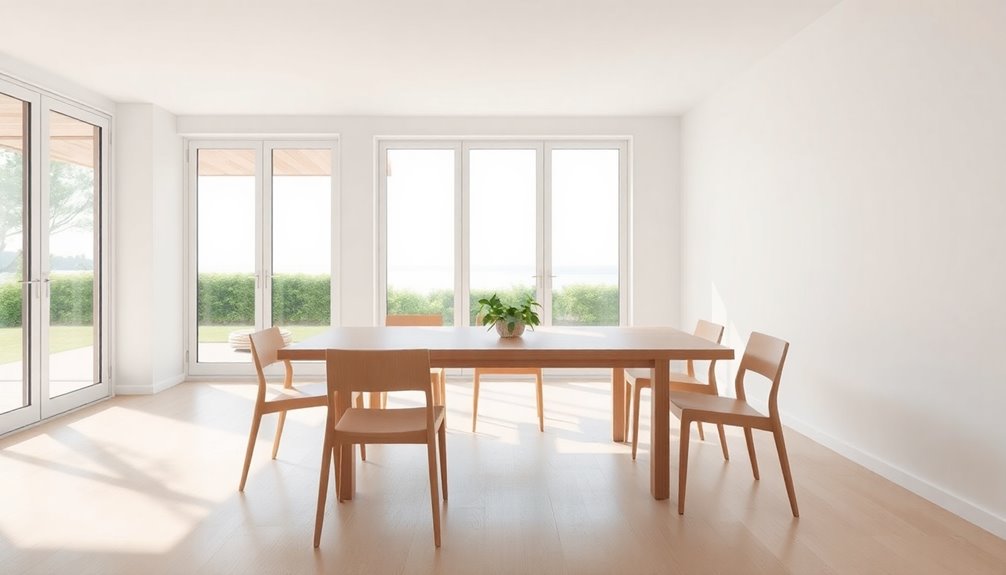
Scandinavian design embodies a philosophy that champions simplicity and functionality. At its core, this design approach embraces minimalism, focusing on clean lines and minimal decoration to create serene, uncluttered spaces.
You'll notice the integration of natural elements like wood, stone, and textiles, which fosters a calming atmosphere and deepens your connection to nature. A neutral color palette featuring whites, grays, and soft pastels enhances lightness and evokes tranquility in your home.
Multi-functional furniture is another hallmark of Scandinavian design, allowing you to optimize your space and promote practicality, especially in smaller living areas. Additionally, this design philosophy aligns well with the principles of energy-efficient designs, emphasizing sustainable practices that contribute to a greener lifestyle. Overall, this design philosophy celebrates quality craftsmanship, emphasizing durable materials and timeless designs that marry aesthetic appeal with everyday usability.
Historical Roots of Scandinavian Minimalism
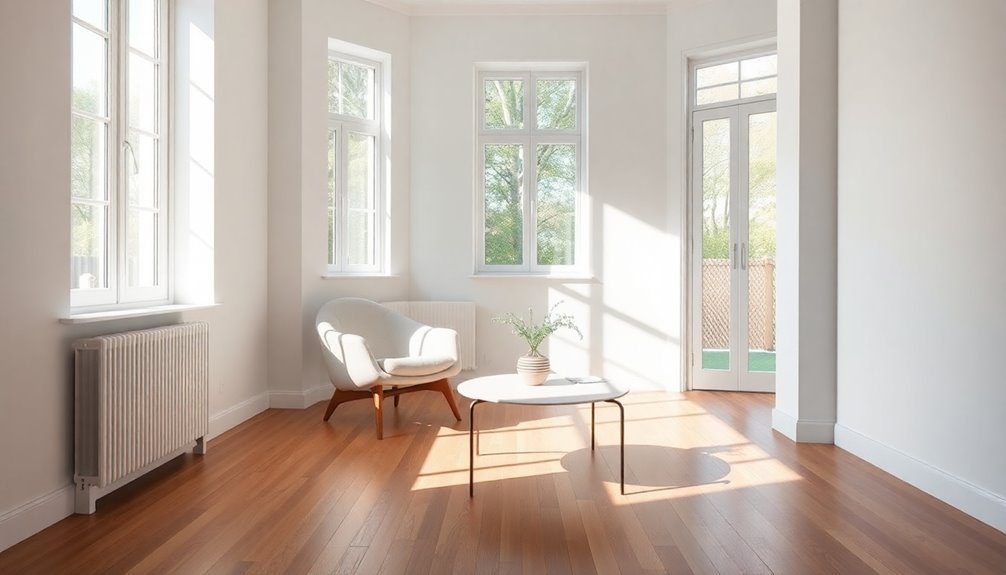
Scandinavian minimalism took shape in the mid-20th century, driven by a need for affordable design in the wake of World War II. Influenced by the Bauhaus movement, designers like Alvar Aalto and Arne Jacobsen focused on creating functional yet beautiful pieces. This evolution in design reflects a commitment to quality that's accessible to everyone, transforming how you think about space and simplicity. Additionally, the philosophy behind minimalism often aligns with the concept of budgeting for simplicity, encouraging individuals to prioritize essential items and reduce excess.
Mid-20th Century Influences
Emerging in the mid-20th century, minimalism in design arose as a practical response to the challenges faced during the post-World War II rebuilding era.
Scandinavian design embraced this minimalist style, focusing on affordability and functionality. Influenced by earlier movements, it emphasized clean lines and simplicity, creating spaces that felt both inviting and airy.
Key figures like Alvar Aalto and Arne Jacobsen championed the history of Scandinavian minimalism, prioritizing quality craftsmanship and enduring aesthetics. Their work aimed to enhance natural light and promote open layouts, countering the long, dark winters typical of the Nordic region.
Brands like IKEA later revolutionized the market, making this minimalist Scandinavian furniture accessible, versatile, and functional for everyday living. Incorporation of natural elements promotes tranquility, a principle that aligns seamlessly with Scandinavian design philosophy.
Bauhaus Movement Impact
The influence of the Bauhaus movement on Scandinavian minimalism is profound and undeniable. Founded in 1919, the Bauhaus emphasized simplicity and functional design, shaping the ethos of Scandinavian designers like Alvar Aalto and Arne Jacobsen.
They embraced the notion of "form follows function," creating pieces that featured clean lines and reflected both beauty and utility. The movement's focus on modern materials and accessibility resonated deeply, leading to designs that weren't only aesthetically pleasing but also practical for everyday use.
This blend of minimalist aesthetics and functionality became a hallmark of Scandinavian design, ensuring that the principles of the Bauhaus movement remain a significant force in contemporary design conversations, influencing countless creators and enthusiasts around the world. Additionally, the emphasis on quality assurance in design processes ensures that products are not only beautiful but also reliable and functional.
Post-War Design Evolution
As post-World War II reconstruction took hold, designers sought to address the urgent need for affordable and functional living solutions. Scandinavian style flourished during this time, emphasizing simplicity and functionality. Natural materials and light-colored walls became staples in homes, creating a minimalist aesthetic that felt both welcoming and practical. Denmark led the way with cost-effective furniture that didn't compromise quality, while Sweden focused on bright, airy interiors to combat long winters. The rise of brands like IKEA in the 1950s made these designs accessible globally, fostering a love for minimalist living. This movement also underscored the importance of continuous learning in design, as creators adapted to changing societal needs and preferences.
| Country | Design Focus | Iconic Brands |
|---|---|---|
| Denmark | Affordable Furniture | Hans J. Wegner |
| Sweden | Bright Interiors | IKEA |
| Finland | Textiles and Ceramics | Marimekko |
| Norway | Functional Design | Stokke |
| Iceland | Sustainable Practices | Gæðingur |
The Importance of Functionality in Design
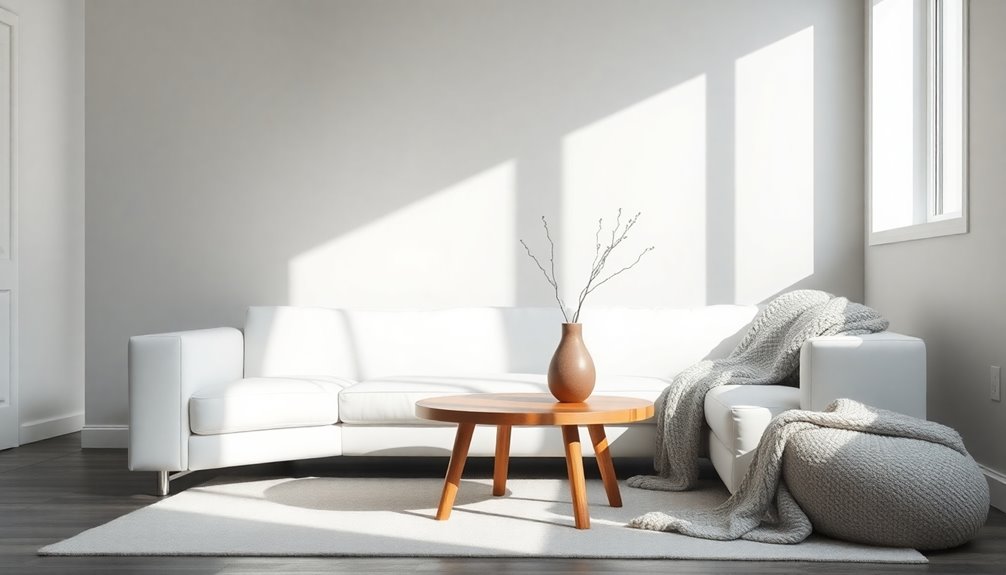
In Scandinavian design, every piece of furniture you choose serves a clear purpose, ensuring that your space feels both functional and inviting. You'll find that space optimization techniques, like multi-functional furniture, can dramatically enhance small living areas. Additionally, this approach aligns with the principle of conscious consumption, encouraging a mindful selection of items that truly add value to your home.
Purposeful Furniture Choices
When you embrace Scandinavian design, you quickly realize that purposeful furniture choices are crucial for creating a functional living space.
This design philosophy prioritizes multi-functional furniture, like convertible sofas and nesting tables, which adapt to your needs and maximize space efficiency, especially in smaller areas.
Scandinavian furniture features clean lines and a minimalist aesthetic, ensuring that each piece serves a specific purpose while enhancing usability.
Quality craftsmanship is essential, guaranteeing that your furniture isn't just functional but durable, promoting sustainable living through long-lasting products.
Additionally, the use of natural materials, such as wood and stone, connects your space with nature, striking a harmonious balance between form and function, making your home both practical and visually appealing.
Incorporating durable materials into your furniture choices ensures that you maintain the integrity of your design while supporting eco-friendly practices.
Space Optimization Techniques
To create a harmonious and functional living space, embracing space optimization techniques is essential. You can start by incorporating multi-functional furniture, like nesting tables and convertible sofas, which maximize your limited space without sacrificing style.
Prioritizing decluttering helps keep only the essentials, fostering an open atmosphere that promotes tranquility. Make the most of natural light by using large windows and light-colored walls, enhancing the sense of space and inviting warmth.
Clever storage solutions, such as built-in cabinetry and under-bed storage, keep your area organized and free from clutter. Finally, using natural materials like wood and stone adds both warmth and practicality, grounding your design while supporting its functionality. Additionally, maintaining cleanliness in your home through regular cleaning routines can further enhance the feeling of space and promote a healthier lifestyle. Embrace these techniques for a beautifully optimized home!
Emphasizing Natural Light and Space
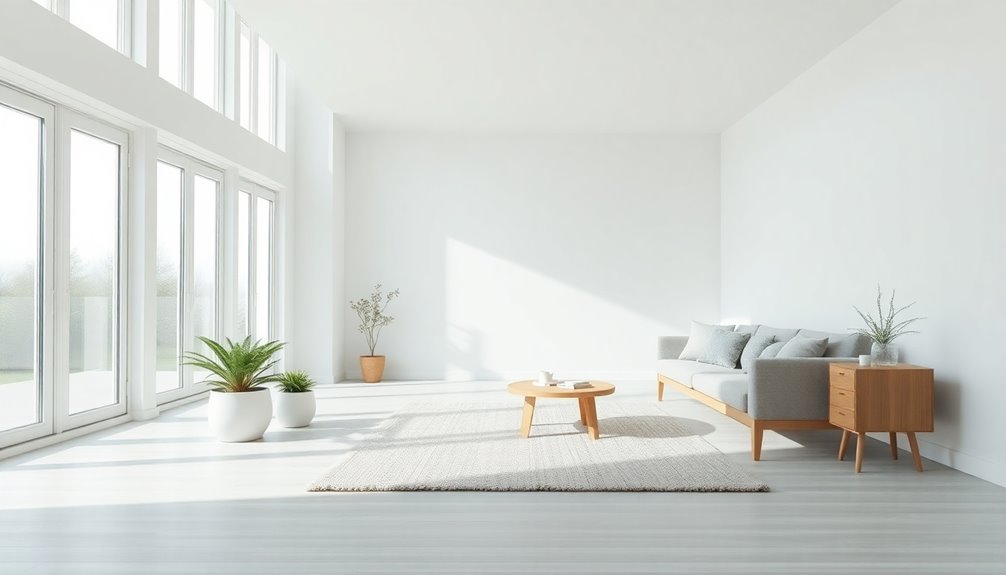
Emphasizing natural light and space is fundamental to Scandinavian design, as it transforms interiors into bright, inviting environments. You'll notice large windows and light-colored walls that create airy spaces, enhancing the feeling of openness. This design philosophy champions decluttered areas, allowing light to flow freely, contributing to a calm and inviting atmosphere. Incorporating elements from traditional Indonesian style can also enhance the connection with nature through the use of natural materials.
| Design Element | Purpose |
|---|---|
| Large Windows | Maximize natural light |
| Neutral Colors | Enhance minimalist aesthetic |
| Multi-functional Furniture | Optimize space and simplicity |
| Indoor Plants | Integrate nature and freshness |
Using mirrors and reflective surfaces amplifies natural light, making smaller spaces feel larger. Together, these elements create a serene environment that embodies Scandinavian minimalism.
Connection to Nature: Elements That Matter
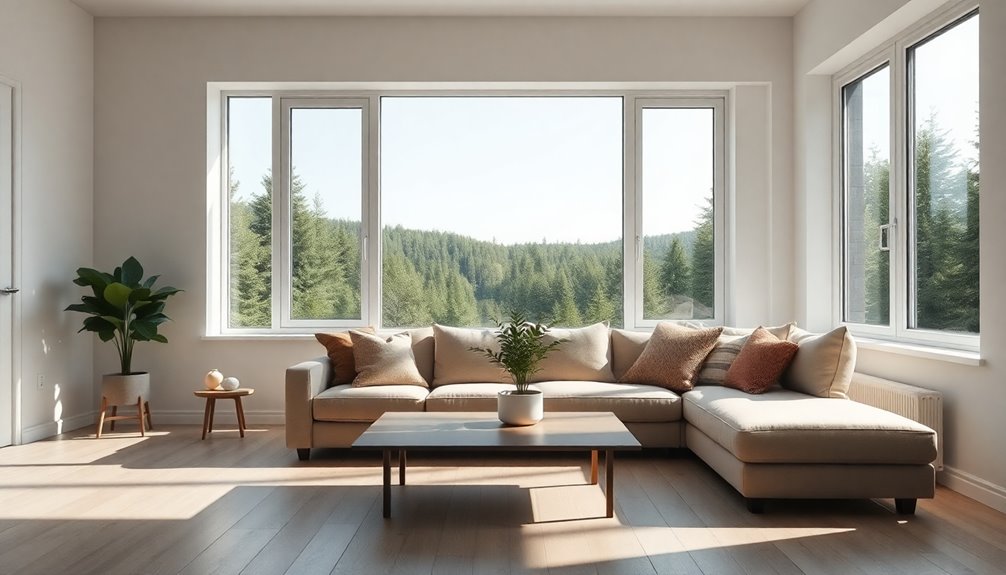
Incorporating natural elements into your home not only enhances its aesthetic appeal but also fosters a sense of tranquility and connection to the outdoors.
Incorporating natural elements in your home enhances beauty and fosters tranquility, creating a soothing connection to nature.
Scandinavian design emphasizes this connection through various aspects:
- Natural Materials: Use wood, stone, and plants to create a calming atmosphere that invites nature inside.
- Earthy Color Palettes: Opt for colors reflecting the natural world, like greens and browns, to promote relaxation and well-being.
- Textures: Incorporate textiles like wool and linen to add warmth and comfort, bridging the indoor space with the outdoors.
Furniture Selection: Prioritizing Multi-functionality
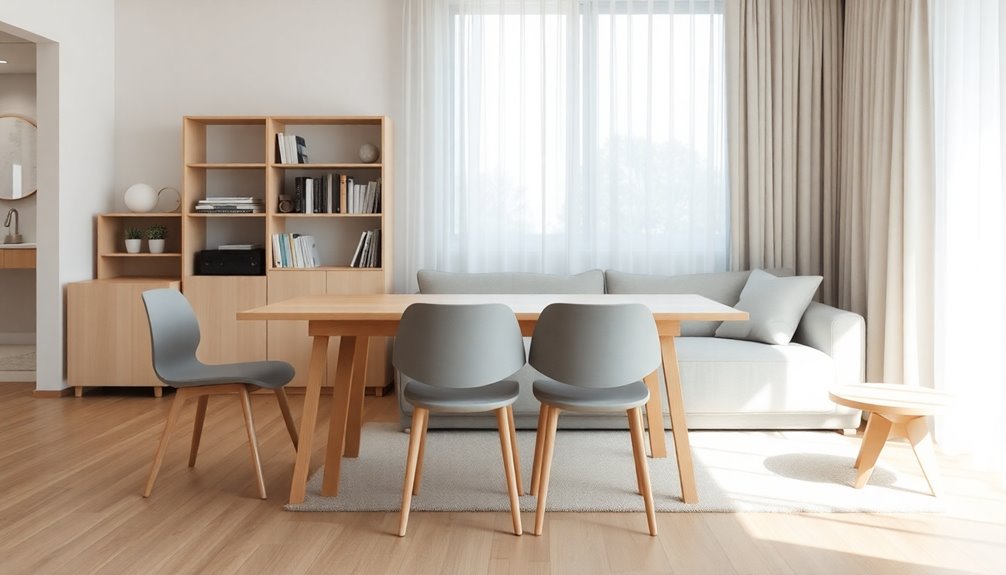
Natural elements create a serene backdrop in Scandinavian design, but the choice of furniture plays a significant role in maximizing that tranquility and functionality.
You'll find that multi-functional furniture is essential for space efficiency, especially in smaller urban living areas. Look for pieces like convertible sofas, nesting tables, and storage ottomans that blend utility and aesthetics seamlessly.
These minimalist designs reduce clutter while enhancing the overall functionality of your space. Scandinavian furniture often features clean lines and simple forms, making it easy to integrate into various interior styles.
Brands like IKEA have made practical design accessible, offering stylish options that embody the principles of Scandinavian minimalism. Additionally, incorporating natural materials like wood can further enhance the warmth and character of your minimalist space.
Embrace this philosophy, and transform your home into a harmonious, efficient haven.
Textiles and Accessories for a Cozy Atmosphere
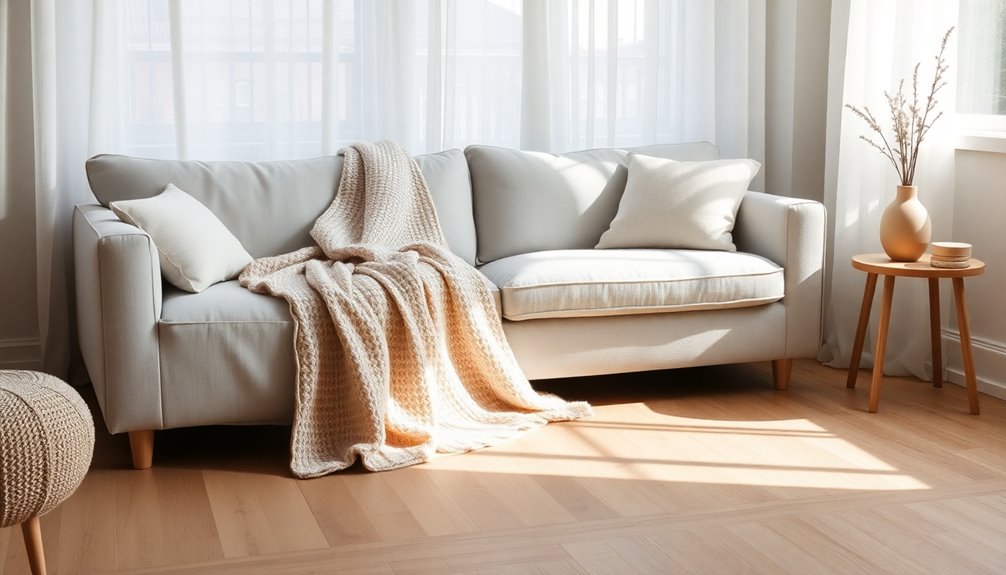
Cozy textiles and thoughtfully chosen accessories are essential in achieving the inviting atmosphere characteristic of Scandinavian design.
To create that perfect blend of comfort and minimalism, consider these key elements:
- Soft Throws: Opt for wool or cashmere blankets in neutral tones. They add warmth without overwhelming the space.
- Geometric Pillows: Use cushions featuring simple patterns that evoke a hygge lifestyle while maintaining a minimalist aesthetic.
- Natural Greenery: Incorporate potted plants or fresh flowers to breathe life into your decor, reflecting the connection to nature prevalent in Nordic countries.
Incorporating Hygge Into Everyday Living
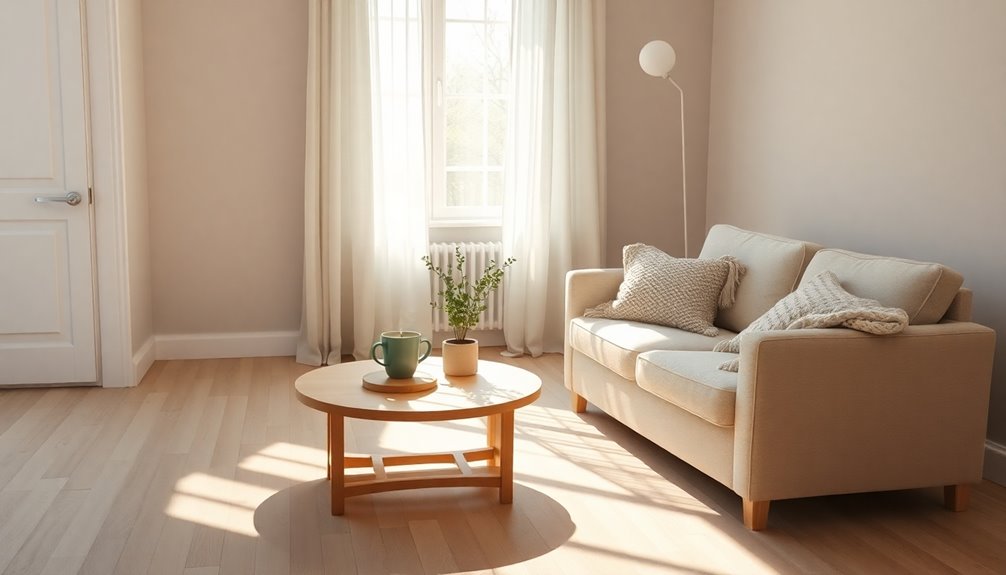
How can you transform your everyday routine into a hygge experience? Start by creating cozy, inviting spaces in your home.
Use natural materials like wood and wool to enhance comfort. Incorporate warm lighting, such as soft lamps or candles, to set a relaxing mood.
Embrace simple pleasures—enjoy a cup of tea by candlelight or snuggle under a soft blanket. Gather with friends and family in these warm settings, fostering connections that enhance your well-being.
Seasonal changes can also add to the hygge vibe; decorate with items that reflect the essence of each season.
Frequently Asked Questions
Why Is Scandinavian Design Minimalist?
Scandinavian design's minimalist approach stems from its focus on functionality and practicality.
You'll notice that every piece has a purpose, reducing clutter in your space. This style also reflects a need for comfort in harsh climates, promoting serenity through clean lines and simplicity.
What Is the Main Concept in Scandinavian Design?
Imagine walking into a serene space where every piece whispers simplicity.
The main concept in Scandinavian design revolves around functionality and minimalism, emphasizing the essentials. You'll notice how each element serves a purpose while creating a warm, inviting atmosphere.
The philosophy of "lagom" plays a key role, promoting balance and moderation in both aesthetics and lifestyle.
With natural light flooding in, you'll feel a deep connection to nature, enhancing your overall experience.
What Are the Principles of Scandinavian Design?
Scandinavian design revolves around several key principles.
You'll notice a focus on simplicity and functionality, creating clean lines and practical spaces. Emphasizing a neutral color palette fosters a calming atmosphere, while natural materials like wood and stone enhance warmth.
Multi-functional furniture helps you optimize smaller living areas, and large windows maximize natural light, making your interiors feel open and airy.
Together, these elements create a serene and inviting environment for everyday living.
Why Is Minimalism so Popular in Design?
Minimalism's popularity in design stems from its focus on simplicity and functionality, which resonates with your desire for serene, clutter-free spaces.
As you navigate a consumer-driven world, minimalism encourages you to prioritize essential items that bring joy and serve a purpose.
The trend also aligns with growing sustainability awareness, promoting high-quality materials and eco-friendly practices.
Plus, social media showcases beautiful minimalist designs, inspiring you to adopt this appealing lifestyle.
Conclusion
In embracing Scandinavian design, you're not just creating a home; you're inviting a lifestyle that celebrates simplicity and comfort. Imagine walking into a space bathed in natural light, where every piece of furniture serves a purpose while still feeling cozy. It's fascinating how a few thoughtful choices can transform your environment into a serene retreat. So, why not take that leap? You might just discover a newfound appreciation for the beauty of minimalism in your everyday life.
